I appreciate the effort into trying to make budget builds or trial deck upgrades. In respect to the former, I don’t think the premise itself really works very well in Weiss. As for the latter, I don’t really see any difference between this and building any average deck. I will go further into detail in this post about my opinion on both and where my logic comes from.

In terms of cost and availability, this is primarily an English exclusive issue. It is very rare for Japanese cards to be fully out of stock, especially for lower rarity cards. This is shown below with Yuyutei’s respective pricing for the Japanese version of the same series.
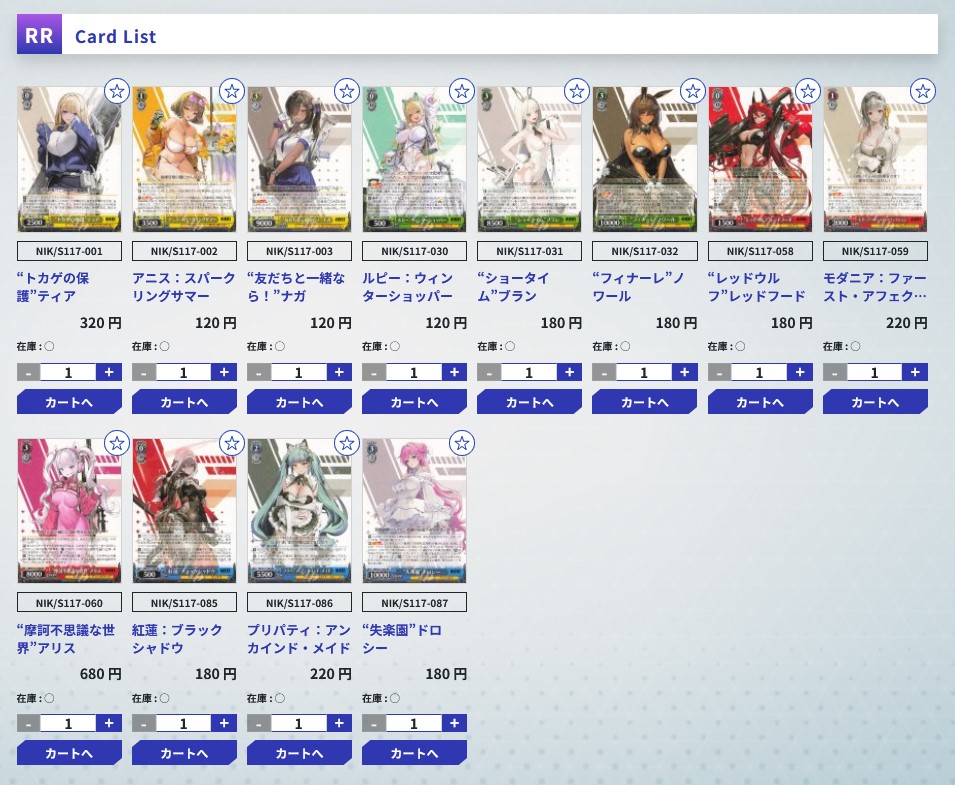
I’m not here to brag or showcase how one format is superior to the other. However, there is a rather wide gap in pricing and availability (the circle indicates there are plenty of copies). As far as low rarity is concerned, if you are buying in Japanese, the costs for the individual cards typically cap out around 1000-2000 yen. The point is, when it comes to budgeting issues, it rarely is a case for Japanese cards typically speaking.
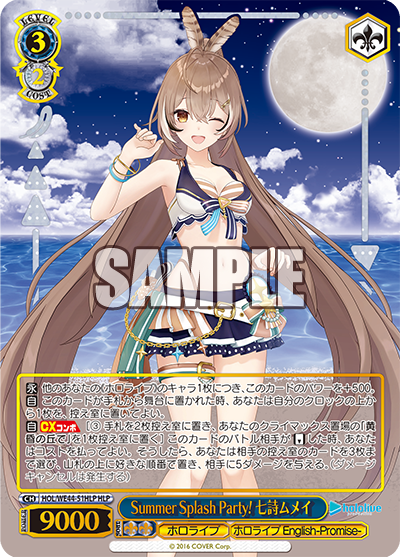


HOL/W104-120SP-SP 未来へと踏み出す一歩 七詩ムメイ (center)
HOL/W104-144CC 黄昏の丘で (right)
The larger issue with budget decks is that the concept just doesn’t work in Weiss. Rarity is an arbitrary value technically speaking. And price points usually scale with rarities, but you cannot simply just choose to buy an alternative. Weiss is not a game where you have a large selection of alternatives to work with. Because of how series are separated from one another, your card pool is exclusively limited to what your set provides you. If you are running the Mumei package above, as an example, you have to buy the 1/0 Mumei and the 3/2 Mumei for the synergy. There is no substitute. This is just a necessary truth.
Now often, the suggestion is to run cheaper combos instead such as lowering the rarity or looking for cards that come with a lower price cost. This will cause your deck to weaken in synergy and leave you scrambling for random pieces to fill in your deck. Weiss is not a game designed to work exclusively with lower rarities. The card pool doesn’t allow for such flexibility. It is not a matter of playing a weaker deck; the truth is you are not running a deck that works anywhere close to the expected shell of the more standard deck.
The limited card pool makes it so you can’t easily brush aside certain card profiles. They’re rather irreplaceable unless you just opt to run without that profile entirely. Running a budget deck isn’t the same as running a standard deck with a few handicaps. The budget deck does not showcase the strength of the standard deck in the slightest. It is a completely different deck altogether. You can play the budget deck to “lower” the power of your deck as a whole, but it will never replicate the full experience of having a completed deck.
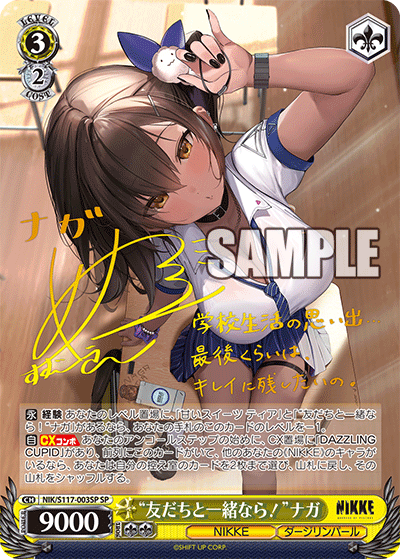
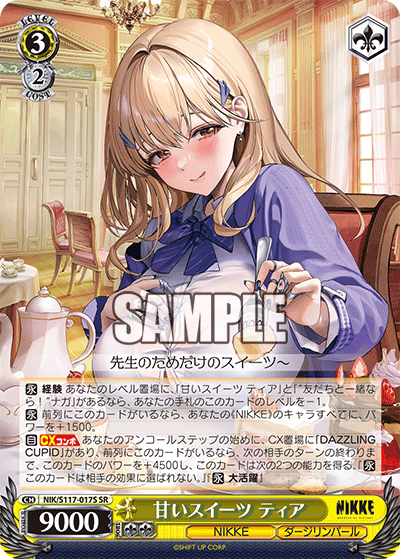

NIK/S117-017S-SR 甘いスイーツ ティア (center)
NIK/S117-027R-RRR DAZZLING CUPID (right)
I had locals try and test a pauper format where players could only play with uncommon cards and below. The format died in a matter of weeks. There were several problems. Firstly, many players in certain sets were unable to facilitate their game plan because several pieces needed to put their idea together were all in higher rarities. Secondly, series that were bigger or newer had several different value pieces that they could slot in or carry alternatives which was not possible for every series.
Games were wildly unfair. And more often than not, the game was determined by whomever managed to field out the largest bodies. In regard to the second point, this is even worse when you consider some series have most of their advantage engines and more locked exclusively to higher rarities. The point is this pauper format was not Weiss in the slightest. It had concepts from the main game, but without the filtering effects, the splashy and explosive combos, and the synergistic pieces that put your deck together, this was not Weiss.
So what do I suggest as an alternative? Look to build more theme based or archetypal decks. Most of these decks typically only carry a handful of the highest base rarity cards. With that in mind, most of your budget costs are usually already covered. Think carefully of whether or not you even need a certain profile in your deck. You can also just vary your ratios accordingly as well. If you are playing a series that is blessed with multiple sets, maybe try looking into an older strategy for your deck.


Moving onto the second type of deck: the trial deck upgrade, I am confused by the principle of this concept. The problem with the concept is the name already implies that the trial deck and booster box upgrade are separate from each other. This doesn’t make sense. Both the trial deck and booster box of each series share the same card pool. You are incentivized to actually mix cards from both into each other.
The other issue is the concept implies that the trial deck is somewhat inferior and that the player looking to upgrade is looking for a cheaper brew. There are plenty of standard decks that feature combos from the trial deck. Some decks even use the finishers from trial decks as well. What I’m trying to say is that there shouldn’t be “trial deck upgrade” as a separate concept. The concept itself is “deck building”. You are expected to consider every product and card designed when building a deck.

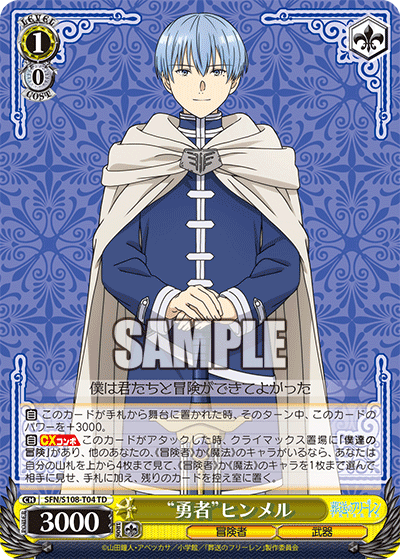
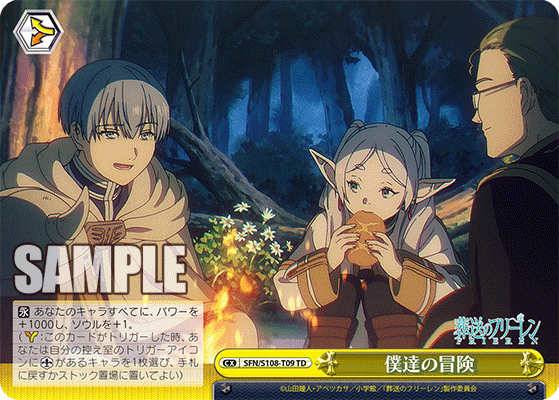
SFN/S108-T04TD “勇者”ヒンメル (center)
SFN/S108-T09TD 僕達の冒険 (right)
By no means am I saying that you are not welcome to try the above. I am just saying that if you are looking for the authentic Weiss experience, you will indefinitely miss out. Weiss is a game built on mirroring the themes of the series that it depicts. And these depictions are married into specific card combinations beyond rarities. The bitter reality is that, regardless of costs, if you want that full experience, you just simply have to purchase those cards together.
I do know that some players come from other card games such as Magic the Gathering and Yu-gi-Oh!, games with alternative formats. Weiss doesn’t operate the same way. There is an additional format that is Standard, but that is a completely different game from the more played Neo-Standard format that most players know. Magic the Gathering shares a pauper format, but the big difference between that format and Weiss’ is that Weiss does not have the card pool to support that type of format. Furthermore, Weiss’ designs are too limited and specific to work in conjunction in a general sense compared to the more loose mana system that exists for Magic. Every card game, despite sharing similar characteristics and maybe some systems, are fundamentally separate games.
The bottom line is hobbies cost money. That’s just reality. And I’m not here to demonize you for not having the cash to follow through with purchasing said cards. I can suggest this: if you want to try a specific deck in English and the costs are too high, maybe consider purchasing the Japanese singles instead as a proxy and giving that a whirl before committing to purchasing the English version. Either way, best of luck in getting your cards.